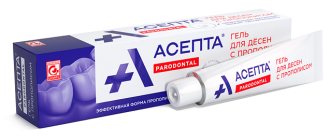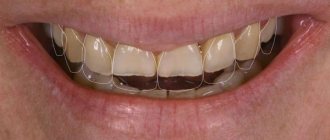Hyperesthesia is the increased sensitivity of tooth enamel to chemical, mechanical and temperature influences. An unpleasant reaction can occur to acidic foods - fruits, berries, as well as hot and cold foods and drinks. Pain may occur during chewing and touching the enamel with a toothbrush.
In ICD-10, this condition is assigned code K 03.8. It is important to understand that often dental hyperesthesia is not an independent disease, but occurs as a result of the development of certain pathologies.
Dental hypersthesia
Dental hyperesthesia is an increase in the reaction of enamel to chemical and temperature provoking factors. Also, painful sensations can occur with acidic foods - fruits and berries. Discomfort is possible when chewing food and hygienic cleaning with a regular brush.
Dental hyperesthesia according to ICD-10, this condition is assigned code K03.8. It is important to understand that in most cases, increased sensitivity of the hard tissues of dental units is not an isolated pathological process. It occurs as a response to concomitant diseases.
In the branches of West Dental family dentistry in Vsevolozhsk and Yanino-1, our specialists, dental therapists, will help solve this problem. They will select the necessary measures for the prevention and treatment of this disease. In this article we will talk in detail about what dental hyperesthesia is and its varieties. You will learn how to prevent its occurrence and fight it.
What to do if you lose tooth enamel?
The problem is not always solved by remineralization and dental varnish. In cases where the enamel is worn out or severely cracked, gentle methods will not help. Modern dentistry offers several solutions with complete or partial preservation of the tooth:
- Veneers and lumineers are the most expensive method; they provide good protection, but do not restore chewing functions.
- Ceramic or zirconium crowns are strong and durable. Requires preliminary preparation of the support.
- Artistic restoration - new generation composite materials are practically indistinguishable from the natural shade, but last a maximum of 10 years.
Causes
Hypersensitivity of hard tissue structures of teeth can develop for certain reasons:
- Mechanical trauma to enamel - when cleaning at home, using an excessively abrasive paste or a brush with hard bristles, applying a lot of force to the enamel.
- Multiple acid exposure - juices, carbonated drinks, fruits and berries.
- The presence of pathological conditions in the oral cavity that violate the integrity of the structure of enamel prisms: carious process, wedge-shaped defect, erosion.
- Gum recession is the exposure of the cervical area of the teeth due to bite pathology, inflammation of the gum tissue, and vitamin deficiency.
- Exposure to radiation - increased occupational hazard, radiation exposure.
Hyperesthesia of tooth enamel may be a temporary phenomenon. Thus, it appears in the first 2 days after professional cleaning due to the removal of hard deposits or office lightening of the enamel.
There are factors that provoke symptoms - heavy smoking; dry mucous membranes due to endocrine pathologies; gagging; gastrointestinal diseases.
Doctor's advice
To reduce tooth sensitivity, it is necessary to follow measures to prevent hyperesthesia:
- stop smoking;
- change the hard brush to a softer one;
- When buying toothpaste, pay attention to its composition and abrasiveness. You should choose hygiene products with potassium, fluorine, calcium, and hydroxyapatite. Low abrasive compounds (RDA 0-70) are recommended for people with enamel hypersensitivity;
- exclude carbonated water, sweet drinks, and sour fruits from the diet;
- eat food warm;
- visit a dental hygienist twice a year for professional hygienic teeth cleaning and enamel remineralization.
Manifestations
Dental hyperesthesia (according to ICD-10 K03.8) is manifested by a brief pain reaction when interacting with irritants. Unpleasant sensations usually do not exceed a few seconds in duration and appear with some regularity under the influence of a disturbing factor.
The severity of the pain varies - from inconvenience to difficulties with cleaning and standard meals. Such symptoms reduce the quality of life and can force you to change your usual diet and lifestyle.
Some of the most severe symptoms occur with improperly formed enamel; carious process at the neck of the coronal part; severe abrasion of chewing surfaces.
High enamel reactivity can occur in one unit or all of them in the oral cavity. With a single lesion, one unit reacts, and with a developing erosive pathological process, the entire row will be affected.
Clinical picture of hyperesthesia and degree of hypersensitivity
Hyperesthesia can manifest itself in different ways. A typical sensation is intense, albeit short-term pain (about 30 seconds), a “shooting” in the jaw due to hot or cold (more often), very salty, sweet, sour foods and drinks. Sometimes severe pain occurs when inhaling cold air.
With hyperesthesia, this reaction occurs constantly, the relief is short-term and insignificant. The patient often cannot identify the tooth that is causing pain. An external examination does not reveal any difference between the teeth in the row, there is no pathological pigmentation, the enamel appears hard and smooth.
Degrees of the pathological process:
- Discomfort is caused by heat or cold exposure, the threshold values of dentin excitability are 5-8 μA.
- Discomfort is caused by heat, cold, salty, sour, sweet; the threshold values of dentin excitability are 3-5 μA.
- Pain is provoked by all irritants, including simple touch; the threshold values of dentin excitability are 1.5-3 µA.
Hypersensitivity significantly complicates oral care; even ordinary cleaning becomes a challenge, and if the process is developed and neglected, it becomes impossible. The enamel and interdental spaces gradually accumulate deposits, which can lead to caries, gingivitis, and periodontitis.
In order not to provoke the development of serious complications, the consequences of hyperesthesia, you need to contact a specialist already at the first stage of the process, with mild sensitivity.
Classification
Clinical studies have resulted in the most complete structuring of dental hyperesthesia (ICD K03.8), based on which the doctor will determine the causes of the pathology and will be able to differentiate it from other diseases. And most importantly, the specialist will be able to make a true diagnosis and formulate the correct treatment tactics. The classification allows us to systematize the factors influencing the occurrence of the disease.
By location:
- Limited - a limited number of units are affected (1-3). Teeth ground for orthopedic structures, or affected by cervical caries.
- Generalized - most of the dentition is affected, sometimes the entire tooth row. The reasons are erosion, gum recession, high abrasion.
By origin:
- due to a decrease in the volume of solid tissue structures.
- volumes of hard tissues do not affect. Associated with periodontal diseases, pathologies of the endocrine, nervous and gastrointestinal systems. Visually, the integrity of the enamel is not compromised.
According to the severity of the pathology:
I—response to temperature;
II - pain when interacting with sweet, sour and bitter foods;
III - pain is caused by all irritants, as well as hygienic cleaning.
The strength of pain reactions depends on the characteristics of the body.
Provoking factors
Hyperesthesia does not appear immediately. There are several factors that you need to pay attention to in order to eliminate them in time. Don't wait for discomfort to appear. It is better to initially develop healthy habits that will help you maintain your health so that you never experience acute dental pain. Sensitivity increases when any of the factors listed below are present.
- Insufficient oral hygiene. Soft plaque is an accumulation of microbes that eat food microparticles stuck in crevices, releasing organic acids that dissolve enamel minerals. Externally, the dental unit looks intact, but the density of the enamel is significantly reduced. Its demineralization occurs. The first alarm bell is increased sensitivity, then caries develops.
- Consumption of certain foods. Juices, wine, sweet soda, fruits, candies, and other sweets contain phosphoric and other acids that negatively affect the strength of enamel.
- Constant use of aggressive whitening pastes containing abrasive and chemical components.
- Ultrasonic cleaning. Under a dense coating, the enamel becomes thinner and becomes loose. After professional cleaning, it is exposed, its sensitivity increases sharply. Usually, dentists, taking this point into account, use strengthening pastes at the end of the procedure for the preventive treatment of tooth sensitivity.
Complications
High reactivity of hard tissue structures of teeth can affect the general condition of a person. Diseases of the psyche and gastrointestinal tract may worsen. Soreness often disrupts the usual diet.
One of the most obvious and severe consequences of hypersensitivity is pulpitis - an inflammatory process that affects the neurovascular tissue inside the tooth. Constant exposure to irritants on the pulp can lead to aggravation of the process, as well as a deterioration in the general condition of the body. Treatment of such a complication is multi-stage and labor-intensive: the pulp is removed, endodontic treatment is carried out, and the coronal part is restored.
It happens that excessive sensitivity is only one symptom of pathology, for example, a harbinger of a wedge-shaped defect. Therefore, it is important to immediately make an appointment with a specialist with this problem in order to determine the provoking factors of the disease and avoid complications. Dentists at the West Dental clinic will help you with this and select fast and high-quality treatment.
Diagnostics
When examined by a specialist, it is important to conduct a thorough differential diagnosis in order to distinguish hypersensitivity from other diseases with similar symptoms:
- pulpitis;
- caries;
- cracked tooth or filling material.
In case of dental hyperesthesia, differential diagnosis consists of a visual and instrumental examination; an X-ray and electroodontodiagnosis (EDD) may be necessary.
A characteristic feature of high enamel reactivity is quickly subsiding acute pain. To identify it, a specialist needs to check the condition of the pulp using X-rays or using EDI. If a preliminary diagnosis of hypersensitivity is made, the doctor performs diagnostic tests to determine the degree of reaction of dental tissues to irritants. Afterwards, the specialist draws up an individual detailed plan for the treatment and prevention of dental hyperesthesia.
Therapy for hyperesthesia
Hyperesthesia is treated comprehensively, in collaboration between the doctor and the patient, because it involves clinical manipulations, specific procedures and self-care.
First of all, the cause of hypersensitivity is eliminated - periodontitis, periodontal disease are treated, low-quality orthopedic structures and fillings are replaced, and cervical defects are eliminated. If there are indications, microplastic correction of the gums is performed, during which it is raised to a normal level and the exposed roots are covered.
Conservative therapy should normalize hydrodynamics in dentin microchannels. Remineralization will reduce the volume of microspaces and normalize phosphorus-calcium metabolism. The patient needs to undergo a course of treatment, during which every day 10 percent calcium gluconate is applied to the surface of the teeth and the enamel is coated with a fluoride-containing preparation.
In order for the life-saving ions to better penetrate the dental tissues, electrophoresis is used. Physiotherapy makes it possible to introduce certain ions and control their concentration. Electrophoresis is absolutely safe if it is carried out by a competent specialist, and the drugs injected into the tissue are non-toxic. Physiotherapy lasts about 2 weeks, but already at the beginning there is an improvement in well-being, and by the end of the course of treatment a stable remission occurs.
The duration of remission will depend on many factors - the characteristics of a person’s hard dental tissues and the quality of self-care for teeth. If conservative therapy with saline applications does not produce a pronounced effect, the enamel is covered with filling material, but this usually occurs in advanced or clinically complex cases.
Hypersthesia in children
Dental hyperesthesia in children, in most cases, is associated with non-carious lesions of the enamel:
- Thinning of enamel prisms, resulting from microcracks and defects;
- Bite pathology leading to abrasion of hard tissue structures;
- Traumatization of teeth;
- Treatment not carried out in a timely manner, leading to exposure of the root parts of baby teeth;
- Abuse of soda and sugar-containing products;
- Adolescence (10-14 years) during the eruption of several permanent teeth with still immature enamel.
At the appointment, the dentist will examine the child and diagnose the pathology. He will tell you in detail about preventive measures (remineralizing therapy, fluoride pastes) and treatment.
Symptoms of the disease
Acute pain in hyperesthesia of hard dental tissues is caused by specific irritants. This could be food, chemical hygiene products, and even changes in air temperature. The most common irritants:
- sour foods - citrus fruits, natural juices;
- mechanical impact - pressure on the tooth with a brush, chewing solid food;
- temperature - hot and cold drinks and foods.
Bursts of pain occur suddenly after exposure to a stimulus and last from a few seconds to several minutes. Both one tooth and several adjacent units can hurt. There are also periods of remission, when pain ceases to bother you for several weeks or months, but this does not mean getting rid of the problem.
Often, sensitive teeth have no external differences - stains, chips or other signs. In this case, hyperesthesia may be associated with a wedge-shaped tooth defect or erosion.
Treatment
The main therapy for hypersensitivity focuses on eliminating provoking causes and slowing down the flow of dentinal fluid in the tubules. This therapeutic regimen is performed:
- Clogging of micropores and cracks in the hard tissue structures of dental units with desensitizers - specialized means that reduce tissue reactivity.
- Narrowing micropores with mineralizing agents. Specialized gels containing fluorine and calcium. Restoring the mineral balance in the hard tissue structures of teeth helps to achieve high results. This technique is a fundamental part of preventive measures to combat caries and other pathological processes.
- Narrowing or complete blockage of tubules in dentin under a directed laser beam.
It is important to know that sensitivity formed due to loss of gingival and bone tissue, gum recession, will require major therapeutic and surgical interventions. It is necessary to perform comprehensive treatment of periodontal disease to restore a full life and diet.
If the symptoms are caused by pathological closing of the jaws, then orthodontic treatment is necessary. So, when the carious process develops, the doctor will remove the affected structures and further restore it with specialized material. If the process is complicated by pulpitis, endodontic treatment will be necessary - extirpation of the pulp bundle, mechanical and medicinal cleaning of the root canals with their further filling. Finally, restoration of the anatomy of the cusps and fissures of the chewing surface with filling material.
West Dental specialists have all the necessary knowledge, and the clinics have high-tech equipment to select and provide suitable therapy, taking into account all the symptoms of the process. Today, gels, pastes, and varnishes with fluorine and calcium are widely used. It is possible to use electrophoresis and vitamin therapy.
Doctors at West Dental branches will provide highly qualified assistance in treatment of any complexity. You can make an appointment for a consultation by phone or on the website.











